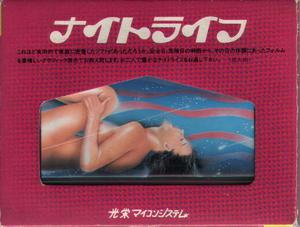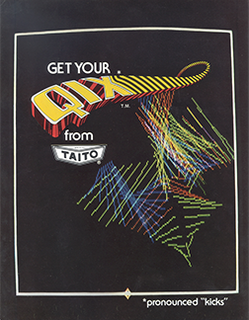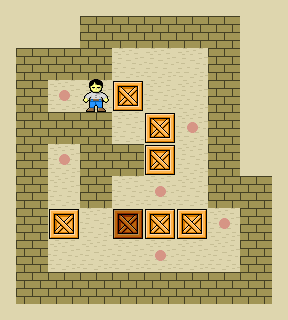 W
WListed here are all 493 known games released for the PC-88.
 W
WThe Black Onyx is a 1984 role-playing video game released in Japan, developed by Bullet-Proof Software, with development led by Henk Rogers. It was one of the first successful Japanese-language RPGs, having sold 150,000 copies, and helped familiarize the Japanese public with RPGs. It was originally released for the NEC PC-8801, and ported to several other platforms. The Famicom version featured completely redesigned gameplay, a new map, and was retitled Super Black Onyx (スーパーブラックオニキス). The Game Boy Color port was developed by Atelier Double and published by Taito. The Game Boy Color port added enhanced visuals and included an option to play through the game with the original game's visual style.
 W
WCrazy Balloon is an arcade game released by Taito in 1980. Crazy Balloon requires the player to maneuver a balloon through a maze full of thorns in order to reach the goal.
 W
WCrazy Climber is a coin-operated arcade game produced by Nichibutsu in 1980. It was released in North America by Taito America by UA Ltd. in 1982 for the Emerson Arcadia 2001 and other video game consoles. It is one of the most acclaimed games in Nichibutsu's library. A precursor to the platform game genre, Crazy Climber was the first climbing-themed video game—specifically, climbing buildings—before Nintendo's 1981 release Donkey Kong.
 W
WDoor Door is a 1983 single-screen platform video game developed and published by Enix in Japan. Originally released for the NEC PC-8801, it was ported to a number of other platforms, including the Family Computer. Controlling a small character named Chun, the player is tasked with completing each stage by trapping different kinds of aliens behind sliding doors. Chun can jump over the aliens and climb ladders, and must also avoid obstacles such as large nails and bombs.
 W
WDragon Slayer is an action role-playing game, developed by Nihon Falcom and designed by Yoshio Kiya. It was originally released in 1984 for the PC-8801, PC-9801, X1 and FM-7, and became a major success in Japan. It was followed by an MSX port published by Square in 1985, a Super Cassette Vision by Epoch in 1986 and a Game Boy port by the same company in 1990 under the name Dragon Slayer I . Both a remake of Dragon Slayer and an emulated copy of the original game are included in the Falcom Classics collection for the Sega Saturn.
 W
WFlappy is a puzzle game by dB-Soft in the same vein as the Eggerland series and Sokoban that is obscure outside Japan. It features Flappy, a somewhat mole-like character who must complete each level by pushing a blue stone from its starting place to the blue tile destination.
 W
WFlicky is a platform game developed by Sega and released in arcades in May 1984. It was licensed to Bally Midway for distribution in the United States. In Flicky, the player controls the eponymous blue bird and must gather all the small birds called Chirps in each round and bring them safely to the exit. There are cat and lizard enemies which can disperse the Chirps and kill the player, but Flicky can use items on the playing field to protect herself and the Chirps from danger.
 W
WGalaxian is a 1979 fixed shooter arcade game developed and published by Namco. It was licensed and distributed by Midway Games in North America. The player assumes control of the Galaxip starfighter in its mission to protect Earth from waves of aliens. Gameplay involves destroying each formation of aliens, who dive down towards the player in an attempt to hit them.
 W
WGrobda is a 1984 multi-directional shooter arcade game developed and published by Namco. It is a spin-off from Xevious, as the player's tank first appeared in that game as an enemy. It runs on Namco Super Pac-Man hardware but with a video system like that used in Mappy and The Tower of Druaga, and it also uses a DAC for the "Get Ready" speech sample at the start of each round.
 W
WHyper Sports is an arcade game published in 1984 by Konami. It is the sequel to 1983's Track & Field and features seven new Olympic events. Like its predecessor, Hyper Sports has two run buttons and one action button per player. The Japanese release of the game sported an official license for the 1984 Summer Olympics.
 W
WLode Runner is a 2D puzzle platform video game, published by Broderbund in 1983. The player controls a character who must collect all the gold pieces in a level and get to the end while being chased by a number of enemies. It is one of the first games to include a level editor.
 W
WMappy is an arcade game by Namco, introduced in 1983 and distributed in the United States by Bally/Midway. A side-scrolling platform game featuring a mouse protagonist and cat antagonists, it runs on Namco Super Pac-Man hardware modified to support horizontal scrolling. The name "Mappy" is likely derived from mappō (まっぽう), a slightly pejorative Japanese slang term for policeman. The game has been re-released in several Namco arcade compilations. It spawned a handful of sequels and a 2013 animated web series developed by cartoonists Scott Kurtz and Kris Straub.
 W
WMario Bros. is a platform game developed and published for arcades by Nintendo in 1983. It was designed by Shigeru Miyamoto and his coworker and Nintendo’s chief engineer Gunpei Yokoi. Italian-American plumber Mario and his brother Luigi exterminate creatures emerging from the sewers by flipping them on their backs and kicking them away. The original versions of Mario Bros.—the arcade version and the Family Computer/Nintendo Entertainment System (FC/NES) version—were received positively by critics.
 W
WMoon Cresta is a fixed shooter video game released in arcades in 1980 by Nichibutsu. It was licensed to Centuri who released it in arcades as Eagle. Incentive Software published ports of Moon Cresta for the Amstrad CPC, Commodore 64, Dragon 32, and ZX Spectrum.
 W
WMystery House is an adventure game released by On-Line Systems in 1980. It was designed, written and illustrated by Roberta Williams, and programmed by Ken Williams for the Apple II. Mystery House is the first graphical adventure game ever and the first game produced by On-Line Systems, the company which would evolve into Sierra On-Line. It is one of the earliest horror video games.
 W
WNight Life (ナイトライフ) is an erotic simulation game by Kōei, released for the PC-8801 computer in April 1982.
 W
WPac-Land is a 1984 side-scrolling platform arcade game developed and published by Namco. In North America, it was distributed by Midway Games. Controlling Pac-Man, the player must make it to the end of each stage to return a lost fairy back to its home in Fairyland. Pac-Man will need to avoid obstacles, such as falling logs and water-spewing fire hydrants, alongside his enemies the Ghost Gang. Eating large flashing Power Pellets will cause the ghosts to turn blue, allowing Pac-Man to eat them for points. It was the first game to run on the Namco Pac-Land hardware.
 W
WPac-Man is a maze arcade game developed and released by Namco in 1980. The original Japanese title of Puck Man was changed to Pac-Man for international releases as a preventative measure against defacement of the arcade machines by changing the P to an F. Outside Japan, the game was published by Midway Games as part of its licensing agreement with Namco America. The player controls Pac-Man, who must eat all the dots inside an enclosed maze while avoiding four colored ghosts. Eating large flashing dots called "energizers" causes the ghosts to turn blue, allowing Pac-Man to eat them for bonus points.
 W
WPoibos Part 1: Dasshutsu is a sci-fi role-playing video game released by ZAT-SOFT for various computer platforms in Japan in 1983. It was originally developed on the premise of sequels, but only the first game was released. Planet name "Poibos" is a reference to the god Phoebus from Greek mythology, with simplified spelling for Japanese audience. Poibos Part 1 is one of the first JRPGs ever created, and the first one in sci-fi setting.
 W
WPortopia Renzoku Satsujin Jiken , often translated to The Portopia Serial Murder Case in English, is an adventure game designed by Yuji Horii and published by Enix. It was first released on the NEC PC-6001 in June 1983, and has since been ported to other personal computers, the Nintendo Famicom, and mobile phone services.
 W
WPrincess Tomato in the Salad Kingdom is a video game by Hudson Soft originally released in 1984 for the NEC PC-8801, NEC PC-6001, FM-7 and MSX Japanese home computers.
 W
WQix is a 1981 puzzle developed by husband and wife team Randy and Sandy Pfeiffer and published in arcades by Taito America. Qix is one of a handful of games made by Taito's American division. At the start of each level, the playing field is a large, empty rectangle, containing the "Qix"–a stick-like entity that performs graceful but unpredictable motions within the confines of the rectangle. The objective is to draw lines that close off parts of the rectangle to fill-in supermajority of the playfield.
 W
WRiver Patrol is a 1981 action arcade video game developed by Orca Corporation and released by GGI in Japan and later licensed to Kersten for distribution in North America. In the game, players assume the role of a captain navigating a river patrol boat to rescue people from the crocodile-infested waters while avoiding obstacles along the way. Initially launched for the arcades, the title was later ported to other platforms, each one featuring various changes compared to the original release.
 W
WSokoban is a puzzle video game genre in which the player pushes crates or boxes around in a warehouse, trying to get them to storage locations.
 W
WTennis is a sports game developed and released by Nintendo for the NES. In North America and Europe, Tennis was one of 17 launch games for the NES. The game was also later released for the Game Boy as a launch title in North America.
 W
WTrack & Field is an Olympic-themed sports arcade game developed by Konami and released in 1983. The Japanese release sported an official license for the 1984 Summer Olympics. Players compete in a series of events, most involving alternately pressing two buttons as quickly as possible to make the onscreen character run faster. It was followed by Hyper Sports and other games in the series.
 W
WXanadu , also known as Xanadu: Dragon Slayer II, is an action role-playing game developed by Nihon Falcom and released in 1985 for the PC-8801, X1, PC-8001, PC-9801, FM-7 and MSX computers. Enhanced remakes were later released for the Sega Saturn, PC-9801 and Windows platforms. It is the second in the Dragon Slayer series, preceded by Dragon Slayer and followed by Dragon Slayer Jr: Romancia, which, as most games in the Dragon Slayer series, have very little relation with each other.